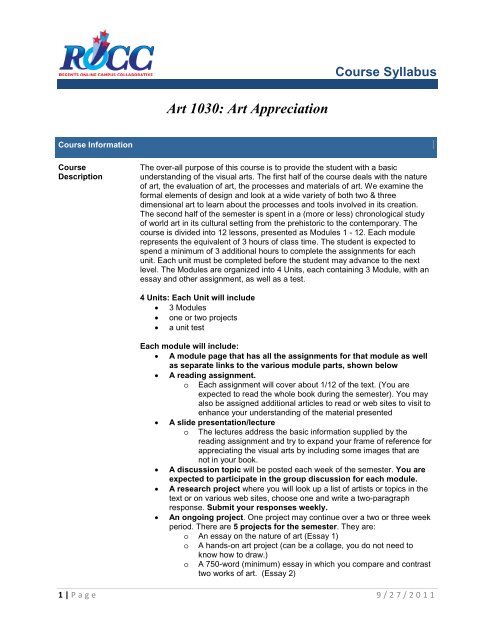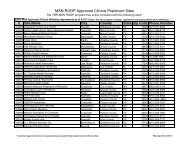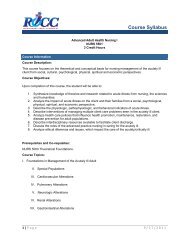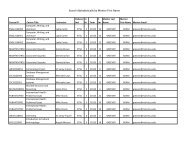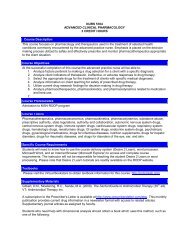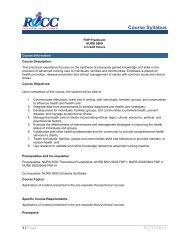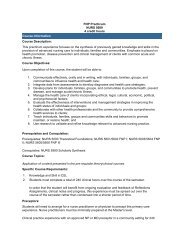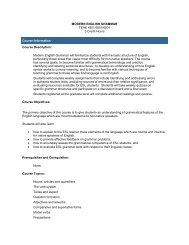Create successful ePaper yourself
Turn your PDF publications into a flip-book with our unique Google optimized e-Paper software.
Course Syllabus<strong>Art</strong> <strong>1030</strong>: <strong>Art</strong> <strong>Appreciation</strong>Course InformationCourseDescriptionThe over-all purpose of this course is to provide the student with a basicunderstanding of the visual arts. The first half of the course deals with the natureof art, the evaluation of art, the processes and materials of art. We examine theformal elements of design and look at a wide variety of both two & threedimensional art to learn about the processes and tools involved in its creation.The second half of the semester is spent in a (more or less) chronological studyof world art in its cultural setting from the prehistoric to the contemporary. Thecourse is divided into 12 lessons, presented as Modules 1 - 12. Each modulerepresents the equivalent of 3 hours of class time. The student is expected tospend a minimum of 3 additional hours to complete the assignments for eachunit. Each unit must be completed before the student may advance to the nextlevel. The Modules are organized into 4 Units, each containing 3 Module, with anessay and other assignment, as well as a test.4 Units: Each Unit will include• 3 Modules• one or two projects• a unit testEach module will include:• A module page that has all the assignments for that module as wellas separate links to the various module parts, shown below• A reading assignment.o Each assignment will cover about 1/12 of the text. (You areexpected to read the whole book during the semester). You mayalso be assigned additional articles to read or web sites to visit toenhance your understanding of the material presented• A slide presentation/lectureoThe lectures address the basic information supplied by thereading assignment and try to expand your frame of reference forappreciating the visual arts by including some images that arenot in your book.• A discussion topic will be posted each week of the semester. You areexpected to participate in the group discussion for each module.• A research project where you will look up a list of artists or topics in thetext or on various web sites, choose one and write a two-paragraphresponse. Submit your responses weekly.• An ongoing project. One project may continue over a two or three weekperiod. There are 5 projects for the semester. They are:o An essay on the nature of art (Essay 1)ooA hands-on art project (can be a collage, you do not need toknow how to draw.)A 750-word (minimum) essay in which you compare and contrasttwo works of art. (Essay 2)1 | P age 9/27/2011
Course SyllabusooAn art review of (or a personal response to) work on display at alocation near you (minimum 500 words) (Essay 3)A group research project and presentationA checklist of the course work by module is availablethrough the checklist tab.CourseObjectives:RerequisitesandCorequisites:The over-all purpose of this course is to encourage an appreciation of the Visual<strong>Art</strong>s. This is a highly visual course, in which we will examine and discuss manyworks of art. We will be looking at, and analyzing, many images in order to gainan understanding of their form and content. We will be analyzing the formalstructure of various works of art as well as considering them in the context of thehistorical period and cultural framework in which they were produced.By the end of this semester, you will be able to:• understand and use the vocabulary of art,• identify some of the purposes of art and the roles of the artist,• distinguish the elements & principles of design and explain how they arebeing used in a given work of art,• recognize some of the materials and processes involved in theproduction of a work of art,• discuss art in a historical and cultural context.None.Course Topics: Unit 1Module 1: The Nature of <strong>Art</strong>, focuses on the nature of art, the various roles thatart and the artist play in their cultural settings, and the response of the viewer.Module 2:The Visual Elements, focuses on the elements of design and theprinciples of organizationModule 3:Two Dimensional Media, investigates the tools and processesinvolved with drawing, painting, printmaking & graphic designUnit 2Module 4: Camera <strong>Art</strong>s and Digital Media, looks at Photography, Film, &Computer ImageryModule 5: Three Dimensional Media, focuses on Sculptural materials andmethods, industrial design, and introduces the materials and processes of the 3D artist.Module 6: Architectural & Environmental Design looks at basic architecturalstructures used by different cultures throughout history and discusses therelevance of architectural planning to our lives.Unit 3Module 7:<strong>Art</strong> in Prehistoric, Ancient & Medieval CulturesModule 8:The Renaissance & the Baroque PeriodsModule 9:Asian <strong>Art</strong>, African <strong>Art</strong> & <strong>Art</strong> from the AmericasUnit 4Module 10:The 18th & 19th centuries.Module 11:Early 20th centuryModule 12:Mid-20th century to the contemporary2 | P age 9/27/2011
Course SyllabusSpecific CourseRequirementsNone.Textbooks, Supplementary Materials, Hardware and Software RequirementsRequiredTextbooks:SupplementaryMaterials:HardwareRequirements:SoftwareRequirements:Please visit the Virtual Bookstore to obtain textbook information for this course:http://rodp.bkstr.comNone needed.The minimum requirements can be found here.This course has a great deal of visual material and is best suited to a fastinternet connection.The minimum requirements can be found here Specific hardware requirementsfor this course include… an Internet browser such as Internet Explorer, Firefox.,Safari, Opera, or Microsoft ExplorerInstructor InformationInstructor Name:Virtual OfficeHours:InstructorResponse Time:Please see the separate page inside the course to find instructor contactinformation.Most concerns can be handled by the course e-mail but if you feel that you needto speak by phone we will arrange a time that is convenient to us both by e-mail.Generally will try to respond to your e-mail within 24 hrs.Assessment and GradingTestingProcedures:There are 4 tests, one for each unit. They will be given on-line and will havematching and multiple-choice questions. There will be a slide identificationportion. The tests are timed for one hour and will self-submit when it is over. Astudy sheet and images will be available shortly before the tests.3 | P age 9/27/2011
Course SyllabusGradingProcedure:Your grade for the course will be a based on the percentage of the possible1200 points for the course.• 400 pts. from 4 tests• 100 pts. for Essay 1, an essay on the nature of art• 100 points for a hands on art project• 160 points for Essay 2, a Compare and Contrast essay• 100 points for the group project• 100 points for Essay 3, an art review essay• 120 points (10 points each) for the 12 module discussion posts• 120 points (10 points each) for the 12 module research projectsPlagiarism (presenting someone else's words, ideas or images as if theywere your own) will result in a 0 for the assignment.Grading Scale:A=90 to 100B= 80 to 89C= 70 to 79D= 60 to 69F= below 60(a minus = the first two grades in the category and a plus the last two, i.e. B- =80 or 81 and B+ = 88 or 89). While your final grade will not be a + or - grade,you may receive them on your projects.Assignments and Participation4 | P age 9/27/2011
Course SyllabusAssignmentsand Projects:Please save all written work as word documents (doc or docx), in rich text format (.rtf)or as text files and upload into the assignment dropbox.Essay 1: What Makes <strong>Art</strong>?100 pointsThe text of this essay is to be a minimum of 500 words.Consider what you think of as art and then try to explain what makes it art. What doyou respond to in a work of art? Is it the way it looks, or the way it makes you feel orthe ideas it brings to mind? How important are the formal qualities? How important isthe content? Should one be subservient to the other? These are somewhatsubjective criteria and there are really no right and wrong answers, but please thinkabout the question seriously and be sure to reference actual works of art in yourdiscussion to illustrate your ideas.The text of the question seriously and be sure toreference actual works of art in your discussion to illustrate your ideas.Hands on <strong>Art</strong> Project100 pointsCreate a work of art that makes a statement. It can be done in any medium you like.See what materials you might already have on hand.(i.e. crayons, markers, fabricscraps, paints or any interesting objects that would serve your purpose.) It can becomposed completely of collaged images or found objects so that you do not need tobe able to draw. The work can make a political or social statement or it can be of amore personal nature, but you need to be able to verbalize the basic premise of thepiece. The purpose of this project is to experience some of the processes of creatinga work of art.Essay 2: Compare and Contrast The text of this essay is to be at least 750 words160 points1. Select a work of art from the text (preferably a color image)2. First, spend time looking thoroughly at this work of art, and then write an analysisof it. Think in terms of subject, form and content. Look for the elements of design andthe principles of organization. How is the artist using shape, color, line, and texture?How is the piece balanced? What rhythms are established? Do we get a sense ofmovement? How is he or she using these "formal" aspects to help convey a mood, oridea? Also, you may want to find out a little about the artists and the historical periodthey represent. What do you think was the purpose for making this piece? What doyou think they were trying to say?3. Find another work that is similar in some way. For example, two still-life’s, portraits,landscapes, or works on a similar theme, like mother and child, the crucifixion, etc.Look carefully at both, compare, and contrast the two. Again, think in terms of form,subject and content. How are they similar? In what ways are they different? Bespecific.4. Respond to these works of art, both critically and personally. Do you think they areequally successful as works of art? Why? How do they make you feel? Do you likethem? Why or why not?Essay 3: <strong>Art</strong> Review (at least. 500 words)100 PointsGo to an art exhibition at a museum or gallery near you. Colleges & universities oftenhave art exhibitions on campus. This must be an actual, not a virtual exhibition.5 | P age 9/27/2011
Course Syllabus(Note: The Thomas Kincaid galleries are not acceptable for this assignment) Look atthe whole show and give your overall impression of the show. Does the show have atheme? What kind of work does it include? Choose a piece or two to describe (as youdid in the compare and contrast essay.) Did you like the work? Why or why not?Which pieces were particularly meaningful?The Thomas Kincaid Galleries are not suitable for this assignment.A Group Research Project100 PointsThis project requires that you work together with a group to research a topic andprepare a presentation to teach the class what you have learned. You will chooseone of the broad topics listed below and be put in a group with others interested inthe same topic. Look in your text; find out some possible divisions to break up yourresearch among group members. Each of you research, in books, magazines and onthe web and collect as much information as possible. Compile your information withyour group. Decide what area you want to focus in on and investigate that further.Plan a short PowerPoint presentation of the material you have found. Do not justcopy and paste from a web site. Research and then present what you have learnedin your own words.1. Pre-Columbian <strong>Art</strong> (Aztec, Mayan, Incan, etc.)2. Islamic <strong>Art</strong>3. Oriental <strong>Art</strong>. (Chinese, Japanese, Korean)More detailed info on group project: The groups are self-enrolling. Go to thegroups tab on the navigation bar and choose a topic. (There should only be onegroup for each topic, if there are more, join group 1.)The groups e-mail each other and divide the up research into convenient subtopics(i.e. if the topic is pre-Columbian art. You might divide the research into differentcultures...Mayan, Aztec, Olmec, Incan etc. or you might divide it by media andsomeoneresearch painting someone else the architecture or sculpture, textiles, etc.)When you all compile your research you will make it into a presentation. The bestway to do it is in PowerPoint or Keynote but people have used Word on occasion.Hopefully someone in eachgroup will have the needed software. You should eachsend that person your text and images for your part of the research (be very clearabout which image goes with what text) When the presentations isfinished, submit it,via the dropbox and I will turn it into html so it will be viewed by the class through thecourse resources group projects link. Each student should either submit thepresentation or a statement that they participated in whatever group they choose.Weekly Research Projects10 Points each120 Points TotalWeekly Discussion Questions10 Points each120 Points Total6 | P age 9/27/2011
Course SyllabusClassParticipation:Punctuality:You are expected to keep up with the work and to participate in the weeklygroup discussions. Please keep up with the work.Although this class is never expected to be on line at the same time it is important tokeep up with the class schedule. Each module has several parts to it and takes timeto do. A class calendar with due dates of all projects will be posted. All assignmentsshould be done in a timely way and submitted through the Dropbox link aboveCourse Ground RulesGuidelines for CommunicationsE-mail:DiscussionGroups:Chat:WebResources:Always include a subject lineUse standard fonts.Send your assignments as attachmentsReview the discussion threads thoroughly before entering the discussionRemember without facial expressions some comments may be taken the wrong way.Choose your words carefully.Do not make insulting or inflammatory statements to other members of the discussiongroup. Be respectful of others ideas.Be patient and read the comments of other group members thoroughly before enteringyour remarks.Be cooperative with group leaders in completing assigned tasks.Be positive and constructive in group discussions.Respond in a thoughtful and timely manner.No chat is required for this class. Chat rooms may be established for group researchproject if students desire them.http://www.google.com is an excellent search engine that will usually turn up reliablesources on just about any search. The Library at my home school has a good pagethat has info on how to write papers, as well as many good subjectindexes.http://www.jscc.edu/library.Also there are several good sites for doing basic research in the art field, they are:http://www.artchive.com;http://sunsite.dk/cg;http://www.wwar.com;www.artcyclopedia.com7 | P age 9/27/2011


